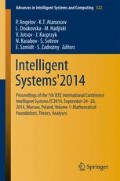Abstract
The uncertainty theory solves problems with uncertain data. Often to perform arithmetic operations on uncertain data, the calculations on intervals are necessary. Interval arithmetic uses traditional mathematics in the calculations on intervals. There are many methods that solve the problems of uncertain data presented in the form of intervals, each of them can give in some cases different results. The most known arithmetic, often used by scientists in calculations is Moore interval arithmetic. The article presents a comparison of Moore interval arithmetic and multidimensional RDM interval arithmetic. Also, in both Moore and RDM arithmetic the basic operations and their properties are described. Solved examples show that the results obtained using the RDM arithmetic are multidimensional while Moore arithmetic gives one-dimensional solution.
Access this chapter
Tax calculation will be finalised at checkout
Purchases are for personal use only
Preview
Unable to display preview. Download preview PDF.
References
Boading, L.: Uncertainty theory, 2nd edn. Springer (2007)
Dymova, L.: Soft computing in economics and finance. Springer, Heidelberg (2011)
Klir, G.J., Yuan, B.: Fuzzy sets, fuzzy logic, and fuzzy systems. Selected paper by L. Zadeh, World Scientic, Singapor, New Jersey (1996)
Liu, S., Lin Forest, J.Y.: Grey systems, theory and applications. Springer, Heidelberg (2010)
Moore, R.E.: Interval analysis. Prentice Hall, Englewood Cliffs (1966)
Moore, R.E., Kearfott, R.B., Cloud, J.M.: Introduction to interval analysis. SIAM, Philadelphia (2009)
Pedrycz, W., Gomide, F.: Fuzzy systems engineering. Wiley, Hoboken (2007)
Pedrycz, W., Skowron, A., Kreinovich, V. (eds.): Handbook of granular computing. Wiley, Chichester (2008)
Piegat, A.: On practical problems with the explanation of the difference between possibility and probability. Control and Cybernetics 34(2) (2005)
Piegat, A., Landowski, M.: Is the conventional interval-arithmetic correct? Journal of Theoretical and Applied Computer Science 6(2), 27–44 (2012)
Piegat, A., Landowski, M.: Multidimensional approach to interval uncertainty calculations. In: Atanassov, K.T., et al. (eds.) New Trends in Fuzzy Sets, Intuitionistic: Fuzzy Sets, Generalized Nets and Related Topics, Volume II: Applications, Warsaw, Poland. IBS PAN - SRI PAS, Warsaw, pp. 137–151 (2013)
Piegat, A., Landowski, M.: Two Interpretations of Multidimensional RDM Interval Arithmetic - Multiplication and Division. International Journal of Fuzzy Systems 15(4), 488–496 (2013)
Piegat, A., Landowski, M.: Correctness-checking of uncertain-equation solutions on example of the interval-modal method. Paper presented on Twelfth International Workshop on Intuitionistic Fuzzy Sets and Generalized Nets, Warsaw, Poland (October 11, 2013)
Sevastjanov, P., Dymova, L., Bartosiewicz, L.: A framework for rule-base evidential reasoning in the interval settings applied to diagnosing type 2 diabets. Expert Systems with Applications 39, 4190–4200 (2012)
Author information
Authors and Affiliations
Corresponding author
Editor information
Editors and Affiliations
Rights and permissions
Copyright information
© 2015 Springer International Publishing Switzerland
About this paper
Cite this paper
Landowski, M. (2015). Differences between Moore and RDM Interval Arithmetic. In: Angelov, P., et al. Intelligent Systems'2014. Advances in Intelligent Systems and Computing, vol 322. Springer, Cham. https://doi.org/10.1007/978-3-319-11313-5_30
Download citation
DOI: https://doi.org/10.1007/978-3-319-11313-5_30
Publisher Name: Springer, Cham
Print ISBN: 978-3-319-11312-8
Online ISBN: 978-3-319-11313-5
eBook Packages: EngineeringEngineering (R0)

